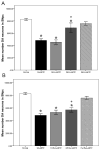Exercise protects against MPTP-induced neurotoxicity in mice
- PMID: 20116369
- PMCID: PMC2884060
- DOI: 10.1016/j.brainres.2010.01.053
Exercise protects against MPTP-induced neurotoxicity in mice
Abstract
Exercise has been shown to be potently neuroprotective in several neurodegenerative models, including 1-methyl-4-phenyl-1, 2, 3, 6-tetrahydropyridine (MPTP) model of Parkinson's disease (PD). In order to determine the critical duration of exercise necessary for DA neuroprotection, mice were allowed to run for either 1, 2 or 3months prior to treatment with saline or MPTP. Quantification of DA neurons in the SNpc show that mice allowed to run unrestricted for 1 or 2months lost significant numbers of neurons following MPTP administration as compared to saline treated mice; however, 3months of exercise provided complete protection against MPTP-induced neurotoxicity. To determine the critical intensity of exercise for DA neuroprotection, mice were restricted in their running to either 1/3 or 2/3 that of the full running group for 3months prior to treatment with saline or MPTP. Quantification of DA neurons in the SNpc show that mice whose running was restricted lost significant numbers of DA neurons due to MPTP toxicity; however, the 2/3 running group demonstrated partial protection. Neurochemical analyses of DA and its metabolites DOPAC and HVA show that exercise also functionally protects neurons from MPTP-induced neurotoxicity. Proteomic analysis of SN and STR tissues indicates that 3months of exercise induces changes in proteins related to energy regulation, cellular metabolism, the cytoskeleton, and intracellular signaling events. Taken together, these data indicate that exercise potently protects DA neurons from acute MPTP toxicity, suggesting that this simple lifestyle element may also confer significant protection against developing PD in humans.
Copyright 2010 Elsevier B.V. All rights reserved.
Figures



Similar articles
-
Intervention with exercise restores motor deficits but not nigrostriatal loss in a progressive MPTP mouse model of Parkinson's disease.Neuroscience. 2015 Jul 23;299:156-74. doi: 10.1016/j.neuroscience.2015.04.069. Epub 2015 May 2. Neuroscience. 2015. PMID: 25943481
-
Cannabinoid receptor type 1 protects nigrostriatal dopaminergic neurons against MPTP neurotoxicity by inhibiting microglial activation.J Immunol. 2011 Dec 15;187(12):6508-17. doi: 10.4049/jimmunol.1102435. Epub 2011 Nov 11. J Immunol. 2011. PMID: 22079984
-
Neuroprotection in Parkinson models varies with toxin administration protocol.Eur J Neurosci. 2006 Dec;24(11):3174-82. doi: 10.1111/j.1460-9568.2006.05192.x. Eur J Neurosci. 2006. PMID: 17156378
-
Dose-related biphasic effect of the Parkinson's disease neurotoxin MPTP, on the spread, accumulation, and toxicity of α-synuclein.Neurotoxicology. 2021 May;84:41-52. doi: 10.1016/j.neuro.2021.02.001. Epub 2021 Feb 4. Neurotoxicology. 2021. PMID: 33549656
-
MPTP: insights into parkinsonian neurodegeneration.Neurotoxicol Teratol. 2002 Sep-Oct;24(5):607-20. doi: 10.1016/s0892-0362(02)00222-2. Neurotoxicol Teratol. 2002. PMID: 12200192 Review.
Cited by
-
Physical exercise as a preventive or disease-modifying treatment of dementia and brain aging.Mayo Clin Proc. 2011 Sep;86(9):876-84. doi: 10.4065/mcp.2011.0252. Mayo Clin Proc. 2011. PMID: 21878600 Free PMC article. Review.
-
An 8-Week Low-Intensity Progressive Cycling Training Improves Motor Functions in Patients with Early-Stage Parkinson's Disease.J Clin Neurol. 2018 Apr;14(2):225-233. doi: 10.3988/jcn.2018.14.2.225. J Clin Neurol. 2018. PMID: 29629527 Free PMC article.
-
Protective Mechanisms of Flavonoids in Parkinson's Disease.Oxid Med Cell Longev. 2015;2015:314560. doi: 10.1155/2015/314560. Epub 2015 Oct 20. Oxid Med Cell Longev. 2015. PMID: 26576219 Free PMC article. Review.
-
Acute Effects of 1-methyl-4-phenyl-1,2,3,6-tetrahydropyridine (MPTP) or Paraquat on Core Temperature in C57BL/6J Mice.J Parkinsons Dis. 2015;5(2):389-401. doi: 10.3233/JPD-140424. J Parkinsons Dis. 2015. PMID: 25633843 Free PMC article.
-
The Effect of 12 Weeks of Cawthorne-Cooksey Exercises on Balance and Quality of Life in Patients with Parkinson's Disease.Med J Islam Repub Iran. 2023 Nov 20;37:125. doi: 10.47176/mjiri.37.125. eCollection 2023. Med J Islam Repub Iran. 2023. PMID: 38318402 Free PMC article.
References
-
- Andreeva AV, Kutuzov MA, Voyno-Yasenetskaya TA. A ubiquitous membrane fusion protein alpha SNAP: a potential therapeutic target for cancer, diabetes and neurological disorders? Expert Opin Ther Targets. 2006;10:723–33. - PubMed
-
- Anstrom KK, Schallert T, Woodlee MT, Shattuck A, Roberts DC. Repetitive vibrissae-elicited forelimb placing before and immediately after unilateral 6-hydroxydopamine improves outcome in a model of Parkinson’s disease. Behav Brain Res. 2007;179:183–91. - PubMed
-
- Bender A, Krishnan KJ, Morris CM, Taylor GA, Reeve AK, Perry RH, Jaros E, Hersheson JS, Betts J, Klopstock T, Taylor RW, Turnbull DM. High levels of mitochondrial DNA deletions in substantia nigra neurons in aging and Parkinson disease. Nat Genet. 2006;38:515–7. - PubMed
MeSH terms
Substances
Grants and funding
LinkOut - more resources
Full Text Sources

